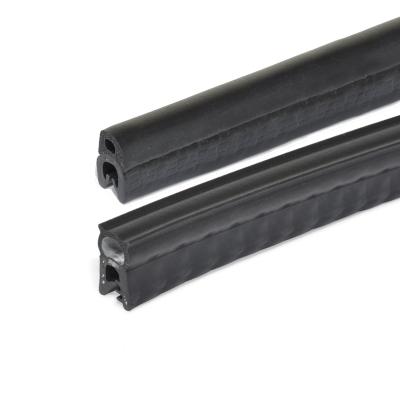
J.W. Winco Inc. offers GN 2180 and GN 2182 edge-protection seal profiles. These RoHS-compliant seal profiles, which can be used to seal doors, covers and hatches, are pressed by hand onto the front of metal sheets and plates. The embedded clamp insert prevents detachment, so glue or other adhesives are not required. When assembled, the profile should deform slightly, which ensures an optimal seal. Adherence to the guideline placement radii is recommended in order to ensure a tight profile seal and to make assembly easier.
Version 2180 is made from ethylene propylene diene monomer (EPDM) rubber in black, with clamping profile hardness of 65 ±5 Shore A and sealing profile hardness of 25 ±5 Shore A. The EPDM profiles, which are temperature resistant from -40° to 100° C (-40° to 212° F), are certified according to UL 50 and UL 94-HB.
The profile seal can also come in black acrylonitrile butadiene rubber (NBR). For sizes 20.5 mm and 13 mm, they have a clamping profile hardness of 60 ±5 Shore A and a sealing profile hardness of 25 ±5 Shore A. The NBR profiles, which are recommended for use in cases where contact with fuels, oils, or coolants can occur, are temperature resistant to -30° to 100° C (-22° to 212° F).
The clamp insert for both has a steel wire polyester clamping band inside the body of the seal profile.
Version 2182’s clamping profile is Polyvinyl chloride (PVC) in black, with a hardness of 70±5 Shore A. The sealing profile is EPDM in black, with hardness of 25 ±5 Shore A. The clamp insert is a steel clamping band, and the profile is temperature resistant from -40° to 90° C (-40° to 194° F).
Contact Details
Related Glossary Terms
- bandsaw blade ( band)
bandsaw blade ( band)
Endless band, normally with serrated teeth, that serves as the cutting tool for cutoff or contour band machines.
- hardness
hardness
Hardness is a measure of the resistance of a material to surface indentation or abrasion. There is no absolute scale for hardness. In order to express hardness quantitatively, each type of test has its own scale, which defines hardness. Indentation hardness obtained through static methods is measured by Brinell, Rockwell, Vickers and Knoop tests. Hardness without indentation is measured by a dynamic method, known as the Scleroscope test.






